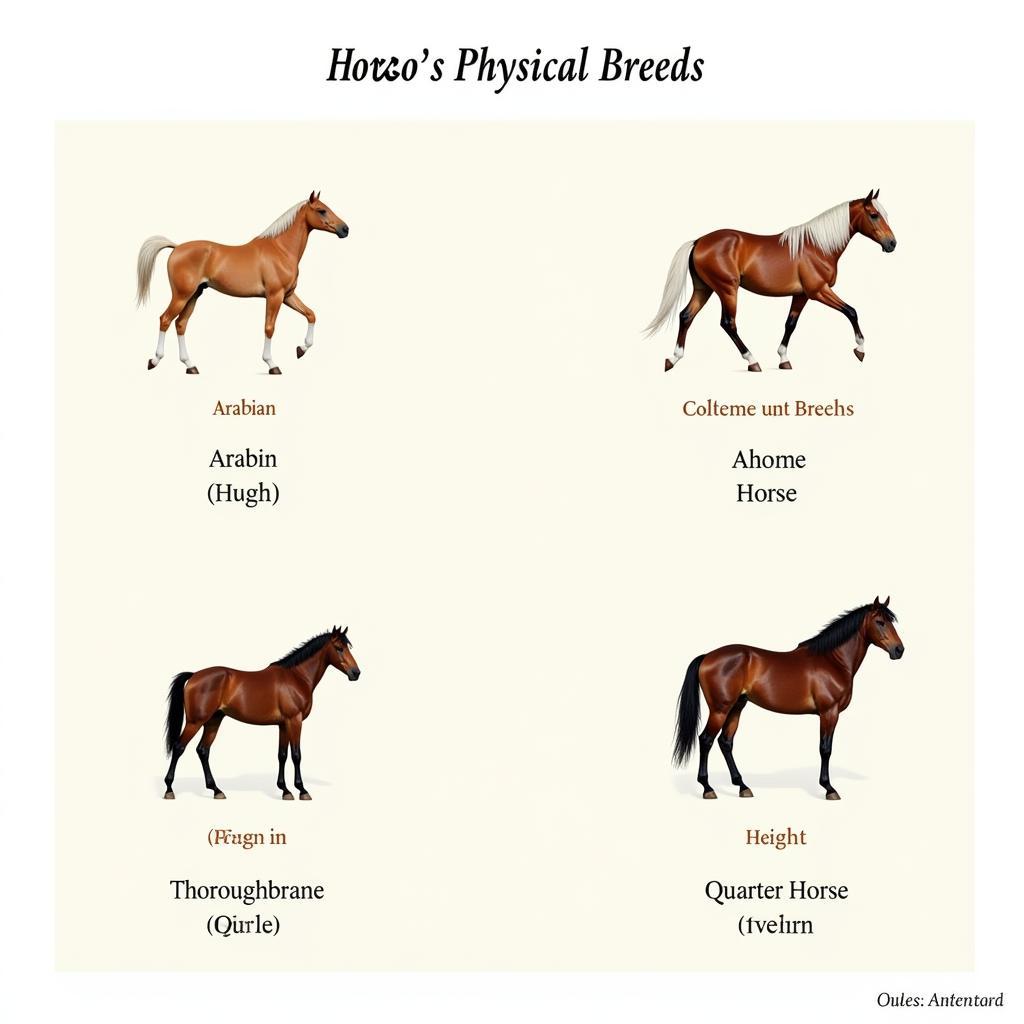Horse Standards encompass a broad spectrum of criteria used to evaluate and categorize horses based on various factors like breed, conformation, performance, and intended use. Whether you’re a seasoned equestrian or just beginning your journey into the world of horses, understanding these standards is crucial for responsible ownership, effective training, and successful competition.  Comparing Different Horse Breed Standards
Comparing Different Horse Breed Standards
Defining Horse Standards: What You Need to Know
Horse standards are essentially benchmarks used to define the ideal characteristics of a horse within a specific context. These standards can vary significantly depending on the purpose. For example, the standards for a dressage horse will differ greatly from those of a racehorse or a working cow horse. Understanding these distinctions helps owners select the right horse for their needs and goals.
What are the key factors contributing to horse standards? Conformation, which refers to the physical structure and build of a horse, plays a vital role. Breed standards often dictate specific conformational traits, like the desired height, leg length, and overall balance. Performance standards, on the other hand, focus on a horse’s athletic abilities, such as speed, agility, and stamina.
Breed Standards: A Closer Look
Different breeds have been developed over centuries for specific purposes, resulting in a wide array of physical and temperamental characteristics. Breed standards serve as a blueprint for maintaining the integrity and consistency within each breed. These standards typically outline desired physical traits, including coat color, markings, and overall conformation. They may also encompass temperament and gait characteristics. For instance, the Arabian horse is known for its refined head, arched neck, and high tail carriage, while the Clydesdale is recognized for its massive size, feathered legs, and gentle disposition. Are you looking for the right horse riding vest for your chosen breed? Check out our collection here: horse riding vest.
Navigating Breed Registries and Associations
Various breed registries and associations play a critical role in establishing and upholding breed standards. These organizations maintain studbooks, track pedigrees, and often host breed shows and competitions. They act as guardians of breed integrity, ensuring that horses registered with them conform to the established standards.
Performance Standards: Measuring Athletic Ability
Beyond breed standards, performance standards are essential for evaluating a horse’s athletic capabilities within a specific discipline. These standards vary depending on the sport or activity, whether it’s racing, jumping, dressage, or other equestrian disciplines. For example, in horse racing, speed and stamina are paramount, while in dressage, precise movements and graceful gaits are highly valued. Looking to improve your horse’s performance? Consider our range of organic horse supplements.
The Role of Competition in Setting Standards
Competitions play a crucial role in shaping and evolving performance standards. Through competition, trainers and riders constantly strive to improve their horses’ abilities, pushing the boundaries of what’s considered achievable. This ongoing pursuit of excellence helps refine performance standards over time. Learn more about upcoming horse shows and competitions at horse and colt show 2023.
“Consistent training and meticulous attention to detail are essential for achieving high performance standards,” says renowned equine trainer, Amelia Hernandez. “It’s not just about natural talent; it’s about developing the horse’s full potential through dedicated effort and proper conditioning.”
Why are horse standards important?
Horse standards are vital for several reasons. They provide a framework for breeding, training, and evaluating horses, ensuring that the unique qualities of each breed are preserved. They also facilitate fair competition and enable buyers to make informed decisions based on their specific needs.
“Understanding horse standards allows owners to appreciate the distinct characteristics of different breeds and disciplines,” adds Dr. Emily Carter, a leading equine veterinarian. “It empowers them to make informed choices about horse selection, care, and training, ultimately promoting the well-being of the animal.” Looking for quality jump cups? Explore our selection at horse jump cups. More details about horse jumping standards can be found here: horse jumping standards.
In conclusion, horse standards serve as essential guidelines for understanding, evaluating, and appreciating the diverse world of horses. Whether you’re focused on breed conformation or performance abilities, a thorough understanding of these standards is fundamental to responsible horse ownership and successful equestrian pursuits.
FAQ
- What are the different types of horse standards?
- How are breed standards determined?
- Who enforces horse standards?
- What is the purpose of performance standards?
- How can I learn more about specific breed standards?
- How do horse standards impact horse shows and competitions?
- Where can I find resources on horse conformation and evaluation?
Common Scenarios and Questions
-
Scenario: A beginner rider is looking to purchase their first horse.
- Question: What breed is best suited for a novice rider?
-
Scenario: An experienced competitor wants to improve their horse’s jumping performance.
- Question: What training techniques and exercises can enhance a horse’s jumping ability?
Further Exploration
- Learn more about horse breeds and their specific characteristics.
- Explore various equestrian disciplines and their respective performance standards.
- Research the history and development of horse breeding and showing.
Contact us for support: Phone: 0772127271, Email: [email protected] or visit us at QGM2+WX2, Vị Trung, Vị Thuỷ, Hậu Giang, Việt Nam. We have a 24/7 customer service team.